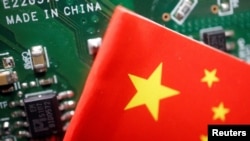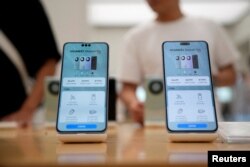On August 29, while U.S. Commerce Secretary Gina Raimondo was visiting China, Chinese telecommunications giant Huawei unveiled its latest smart phone, the Mate 60 Pro.
The new device features an advanced 7 nanometer (nm) chip, the Kirin 9000s, made in China. That means the device can operate as a 5G smartphone.
The processor is the first to utilize 7nm technology produced by Semiconductor Manufacturing International Corporation (SMIC), a partly state-owned Chinese company based in Shanghai. According to TechInsights, an Ottawa, Canada-based company specializing in semiconductor and advanced technology, this suggests that “the Chinese government is making some headway in attempts to build a domestic chip ecosystem.”
The U.S said it's investigating the smartphone for potential violation of the U.S. export controls imposed against Huawei and SMIC over national security concerns that the firms can divert the technology for military use.
Meanwhile, the Mate 60 Pro rollout sent Chinese social and state media into a frenzy, with nationalist netizens launching a fake ad campaign that featured Raimondo as Huawei brand ambassador.
Doctored images captioned: “I am Raimondo, this time I endorse Huawei,” showed Raimondo holding Huawei’s Mate 60 Pro.
State media outlets such as the Global Times and CCTV along with government-tied outlets, including Caixin and SCMP, congratulated Huawei on "breaking through U.S. sanctions" and winning the war of 5G connectivity.
On X, pro-China influencers shared identical messages along with the same video that showed a Mate 60 Pro being taken apart by an unidentified vlogger and seemingly examined:
“In China, this vlogger took apart a Huawei Mate 60 Pro smartphone, and all components are 100% developed/made by China (from Kirin9000S chip to the camera)! This shows that US tech blockade against Huawei failed!”
The claim is partly true, as Huawei's new smartphone possesses 5G technology, which is beyond the threshold set by the U.S. The fact that it's on the market suggests China may be able to mass produce the restricted communications technology.
However, it is premature to say the U.S. export controls targeting the Huawei and SMIC have failed. "Huawei chips show U.S. curbs are porous, not useless," Bloomberg reported. It added: "In reality, last week’s release of the Mate 60 Pro shows that the success of sanctions is painted in shades of grey, with the true impact yet to come."
Chinese media report that despite the euphoria that the Huawei announcement caused, actually purchasing a Mate 60 or Mate 60 Pro poses a challenge, as attempts to place an order in the Huawei online store repeatedly yield a "sold out" message.
That leads experts to question China's ability to mass produce the semiconductors.
Douglas Fuller, an associate professor at Copenhagen Business School, told VOA that being able to make a chip that works, and being able to make millions of chips at good yields that don’t bankrupt a company, are “two very, very different things.”
He questioned whether the 7 nanometer chip is commercially viable, pointing out that there’s no evidence showing SMIC can manufacture 7 nanometer chips “in high volume, high yields and profitably.”
Additionally, the social media enthusiasm about Huawei's alleged victory over U.S. restrictions bears evidence of a Chinese government propaganda campaign: the posts use identical language, are synchronized and mirror the PRC's ideology.
According to Miburo, a research firm that tracks foreign disinformation operations, Beijing has quietly built a network of social media personalities who parrot the government’s perspective in their posts on Western social media platforms like X, Facebook and Instagram. That network includes China’s “own state media employees moonlighting as lifestyle influencers” and “foreigners paid by the CCP “ – the ruling Chinese Communist Party.
Huawei has been accused of engaging in corporate espionage to steal competitors’ intellectual property. In 2020, the U.S. Justice Department charged the company with stealing trade secrets from six U.S. companies over two decades.
There were also documents showing that Huawei helped Chinese authorities create surveillance technology targeting the country’s Uyghur minority population. Huawei denied the accusation.
Under the Trump administration, the U.S. began restricting Huawei’s access to chip making tools that are essential for producing the most advanced 5G handset models. Thus a domestic-made 5G chip would be a major breakthrough for Huawei.
U.S. National Security Adviser Jake Sullivan said that the U.S. needs more information about the precise “character and composition” of China’s new 7 nanometer chip to determine if its development proves that U.S. export controls have failed or that China has violated them.
Meanwhile, U.S. lawmakers are calling for the U.S. Commerce Department to completely end all technology exports to Huawei and SMIC.
For now, the U.S. is continuing to sell chips to China but not its most powerful ones “that China wants for its military,” said U.S. Commerce Secretary Raimondo.
There are also experts who are sounding the alarm that China is indeed making headway with advanced chip production, despite U.S. restrictions.
Paul Triolo, an associate partner for China and technology policy at Albright Stonebridge Group, a Washington DC-based consultancy, said that although he agrees that the new development does not show China can manufacture advanced chips at scale, “it shows what incentives U.S. controls have created for Chinese firms to collaborate and attempt new ways to innovate with their existing capabilities.”
Reuters reported that China is prepared to launch a new state-backed investment fund that will put $40 billion into its semiconductor sector.








